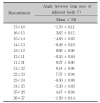1. Frykholm A, Malmgren O, Sämfors KA, Welander U. Angular measurements in orthopantomography. Dentomaxillofac Radiol. 1977. 6:77–81.

2. Floyd P, Palmer P, Palmer R. Radiographic techniques. Br Dent J. 1999. 187:359–365.

3. Wyatt CC, Pharoah MJ. Imaging techniques and image interpretation for dental implant treatment. Int J Prosthodont. 1998. 11:442–452.
4. Lam EW, Ruprecht A, Yang J. Comparison of two-dimensional orthoradially reformatted computed tomography and panoramic radiography for dental implant treatment planning. J Prosthet Dent. 1995. 74:42–46.

5. Frederiksen NL. Diagnostic imaging in dental implantology. Oral Surg Oral Med Oral Pathol Oral Radiol Endod. 1995. 80:540–554.

6. Holdaway RA. Bracket angulation as applied to the edgewise appliance. Angle Orthod. 1952. 22:227–236.
7. Mayoral G. Treatment results with light wires studied by panoramic radiography. Am J Orthod. 1982. 81:489–497.

8. Jarabak JR, Fizzell JA. Technique and treatment with lightwire edgewise appliances. 1972. St Louis: Mosby;277–379.
9. Hatasaka HH. A radiographic study of roots in extraction sites. Angle Orthod. 1976. 46:64–68.
10. Strang RJ. Factors associated with successful orthodontic treatment. Am J Orthod. 1952. 38:790–800.

11. Lucchesi MV, Wood RE, Nortjé CJ. Suitability of the panoramic radiograph for assessment of mesiodistal angulation of teeth in the buccal segments of the mandible. Am J Orthod Dentofacial Orthop. 1988. 94:303–310.

12. Casko JS, Vaden JL, Kokich VG, Damone J, James RD, Cangialosi TJ, et al. Objective grading system for dental casts and panoramic radiographs. American Board of Orthodontics. Am J Orthod Dentofacial Orthop. 1998. 114:589–599.
13. Ursi WJ, Almeida RR, Tavano O, Henriques JF. Assessment of mesiodistal axial inclination through panoramic radiography. J Clin Orthod. 1990. 24:166–173.
14. Xie Q, Soikkonen K, Wolf J, Mattila K, Gong M, Ainamo A. Effect of head positioning in panoramic radiography on vertical measurements: an in vitro study. Dentomaxillofac Radiol. 1996. 25:61–66.

15. Sämfors KA, Welander U. Angle distortion in narrow beam rotation radiography. Acta Radiol Diagn (Stockh). 1974. 15:570–576.

16. Tronje G, Welander U, McDavid WD, Morris CR. Image distortion in rotational panoramic radiography. III. Inclined objects. Acta Radiol Diagn Stockh. 1981. 22:585–592.
17. McDavid WD, Tronje G, Welander U, Morris CR, Nummikoski P. Imaging characteristics of seven panoramic x-ray units. Dentomaxillofac Radiol. 1985. 8:(suppl). 29S–34S.
18. Larheim TA, Svanaes DB, Johannessen S. Reproducibility of radiographs with the Orthopantomograph 5: tooth-length assessment. Oral Surg Oral Med Oral Pathol. 1984. 58:736–741.

19. Larheim TA, Svanaes DB. Reproducibility of rotational panoramic radiography: mandibular linear dimensions and angles. Am J Orthod Dentofacial Orthop. 1986. 90:45–51.

20. Mckee LW, Glover KE, Williamson PC, Lam EW, Heo G, Major PW. The effect of vertical and horizontal head positioning in panoramic radiography on mesiodistal tooth angulations. Angle Orthod. 2001. 71:442–451.
21. Stramotas S, Geenty JP, Petocz P, Darendeliler MA. Accuracy of linear and angular measurements on panoramic radiographs taken at various positions in vitro. Eur J Orthod. 2002. 24:43–52.

22. Schiff T, D'Ambrosio J, Glass BJ, Langlais RP, McDavid WD. Common positioning and technical errors in panoramic radiography. J Am Dent Assoc. 1986. 113:422–426.

23. Choi GL. Accuracy of mesiodistal angulation of teeth in panoramic radiographs [thesis]. 2005. Gwangju: Chosun University.
24. Ash MM. Wheeler's dental anatomy physiology, and occlusion. 1984. Pennsylvania: Saunders Company;387–392.
25. Cohen S, Burns RC. Pathways of the pulp. 2003. St Louis: Mosby;151.
26. Ricketts RM. Cephalometric analysis synthesis. Angle Orthod. 1961. 31:141–156.
27. Ramstad T, Hensten-Pettersen O, Mohn E, Ibrahim SI. A methodological study of errors in vertical measurements of edentulous ridge height on orthopantomographic radiograms. J Oral Rehabil. 1978. 5:403–412.

28. Türp JC, Vach W, Harbich K, Alt KW, Strub JR. Determiningmandibular condyle and ramus height with the help of an orthopantomogram- a valid method? J Oral Rehabil. 1996. 23:395–400.
29. Batenburg RH, Stellingsma K, Raghoebar GM, Vissink A. Bone height measurements on panoramic radiographs: the effect of shape and position of edentulous mandibles. Oral Surg Oral Med Oral Pathol Oral Radiol Endod. 1997. 84:430–435.
30. Kim JD, Kim JS, You CH. Mesiodistal tooth angulation to segmental occlusal plane in panoramic radiography. Korean J Oral Maxillofac Radiol. 2005. 35:25–31.
31. Philipp RG, Hurst RV. The cant of the occlusal plane and distortion in the panoramic radiograph. Angle Orthod. 1978. 48:317–323.
32. Samawi SS, Burke PH. Angular distortion in the orthopantomogram. Br J Orthod. 1984. 11:100–107.

33. Yoon YJ, Kim DH, Yu PS, Kim HJ, Choi EH, Kim KW. Effect of head rotation on posteroanterior cephalometric radiographs. Angle Orthod. 2002. 72:36–42.













 PDF
PDF ePub
ePub Citation
Citation Print
Print



 XML Download
XML Download